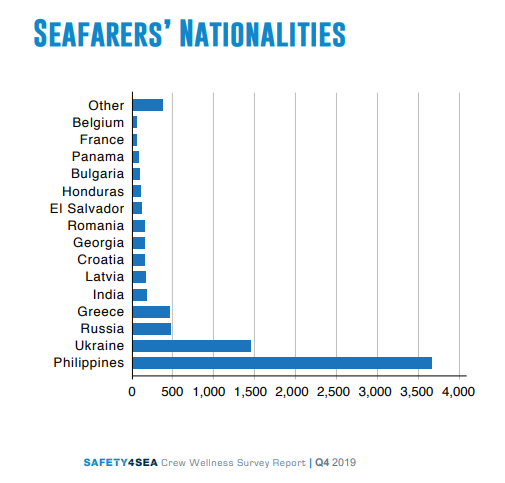
1970 年代,傳統海運國家的海員人數下降,導致供應轉移到諸如 印度, 中國, 和 菲律賓過去50年來,菲律賓已發展成為重要的海洋專業人才輸出國,許多人將其視為世界航海之都。目前,超過1050萬菲律賓人在海外生活和工作,2013年他們向菲律賓匯回了142.3億菲律賓比索(約1.4兆新元)。航運業在其中扮演了重要角色:2013年,約有40萬菲律賓海員在海外工作,向國內匯回了超過142.3億菲律賓比索(約1.4兆新元)的匯款。

菲律賓勞工已被證明是有能力的,並受僱於世界各地的航運公司。世界上有大約80,000艘載重量超過500噸的船舶(載重噸).
菲律賓約有8萬艘船舶,隨時都需要超過140萬名海員,其中菲律賓人佔據了相當大的份額。全球貿易船舶載運量超過901噸,菲律賓人在其中扮演至關重要的角色。 「航海是菲律賓的主要優勢,」菲律賓海事局局長馬克西莫·梅希亞說。 海事工業管理局 (MARINA)“目前,中國為全球輸送了約30%海員,與第二大海員輸出國相差甚遠。”
全球航運業在海員流動、教育和培訓方面擁有完善的實踐。這 國際海事組織 國際海事組織(IMO)總部位於倫敦,負責監督安全標準,其成員國必須被列入“白名單”,以證明其符合培訓、認證和 值班 (STCW) 公約.
此前,菲律賓的治理結構由 海事培訓委員會 (MTC),由勞工和就業部和秘書處主持 碼頭.高等教育委員會(CHED)、技術教育和技能發展局 (泰斯達)、專業規管委員會 (中華人民共和國)、菲律賓海外就業管理局和 菲律賓海岸警衛隊 是在那些服務於 MTC.
這 歐洲海事安全局 2006 年和 2010 年、2011 年和 2012 年再次對菲律賓進行審計,發現許多海事學校和培訓中心不符合 STCW 慣例。它將這歸因於單一當局對各個政府實體的協調缺乏問責制。它還發現,在審計和關閉不合規的學校和培訓中心時,政策、基礎設施、政治意願和問責制缺乏連貫性。
總統貝尼尼奧·阿基諾三世政府於 2012 年頒布了第 75 號行政命令,指定交通和通訊部通過 碼頭,作為唯一負責確保符合 1978 STCW 慣例。
然而,該指令並未凌駕於 CHED, 泰斯達, 或者 中華人民共和國.
2013 年 5 月,海事行業通過菲律賓海事黨 (Angkla) 選舉國會代表,根據一項法律允許部門代表在所有國會席位中擁有最多 20% 的席位。
Angkla 代表 Jesulito Manalo 於 2013 年 7 月宣誓就職,第 16 屆國會提出的第一項法案是共和國法案 (RA) 10635,該法案確立 碼頭 作為負責實施和執行 STCW 經修正的公約,以及與此有關的任何國際協定或公約,在七個月內。
全部 STCW 以前由中華人民共和國承擔的任務轉移到 碼頭 根據法令。
碼頭 菲律賓海員證(或證書)發給菲律賓1000萬僑民中約110萬名在職海員。船上隨時都有近40萬人,其中大多數人最多在船上待10個月後就回國享受兩個月的假期。這相當於全年創造了約40萬個全職工作崗位,創造了超過14.5兆菲律賓比索的匯款,高於2014年的14.56兆菲律賓比索。根據 世界銀行 2013 年的數據顯示,菲律賓的人均年收入不到 $3.000,而海洋產業專家的收入則超過 $13.000。
該部門也存在人力資源差距,因為 建造一艘新船需要不到一年的時間 相比之下,海洋項目的一年級大學生成為碩士或總工程師需要 14 年或 15 年。
結果,合格的工人稀缺,導致工資上漲。
在下面 碼頭, CHED 對海事教育機構有管轄權。
自從被命名為該國統一海洋管理機構以來,MARINA 已列出符合要求的海事學校名單,並更新了課程設置,使其以成果為導向。
在從海事學校畢業之前,學生必須學習三年並完成一年的船上培訓作為學員。
為保證學校提供適當的技術培訓,需要海事部門和教育部門之間的溝通。
這將使提供海洋課程的大學能夠根據行業的未來需求量身定制課程,並專注於培養機械加工、電子和工程領域急需的技能。
碼頭 還設計了一套名為「增強支援等級計畫」的評分系統,旨在考慮當前菲律賓海員培訓的附加價值以及遵守 STCW 認證標準。該計劃旨在改善 菲律賓海員的競爭力 在全球海洋行業通過培訓他們執行支持職能和職責 甲板 並且在 船艦機艙.
鑑於海員,尤其是高級船員的全球短缺,菲律賓人有機會通過回國擔任新興船舶管理和國際航運業輔助服務的專業人士,繼續成為首選海員。擁有高質量的海事學校,成為國際海事教育中心的可能性是存在的。
“歐盟委員會向菲律賓通報了菲律賓海員教育、培訓和認證體系中發現的若干缺陷,包括嚴重缺陷,這些缺陷未能保證滿足 STCW 公約的要求”,歐盟駐菲律賓代表團就菲律賓的 STCW 系統發表聲明說。 (來自 https://mb.com.ph)
菲律賓海員就業市場指南 (來自 https://maritimefairtrade.org)
菲律賓海員的遣返率:對 6,759 例病例的五年研究(來自 https://pubmed.ncbi.nlm.nih.gov)
14個理由:船東為何青睞菲律賓海員-全球三分之一的海員是菲律賓人 (來自 https://safety4sea.com)